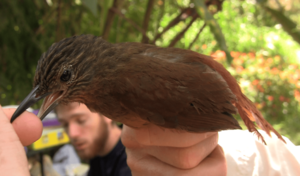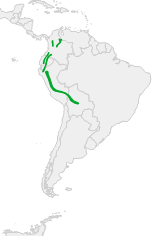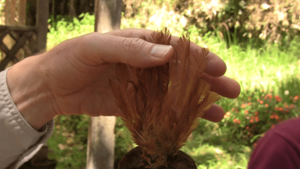Striped treehunter facts for kids
Quick facts for kids Striped treehunter |
|
|---|---|
 |
|
| Captured striped treehunter at Bellavista Reserve, Ecuador | |
| Conservation status | |
| Scientific classification | |
| Genus: |
Thripadectes
|
| Species: |
holostictus
|
 |
|
| Distribution of the striped treehunter | |
| Synonyms | |
|
|
The striped treehunter (Thripadectes holostictus) is a type of bird that belongs to the ovenbird family called Furnariidae. This bird lives in several South American countries, including Bolivia, Colombia, Ecuador, Peru, and Venezuela.
Contents
About Its Family Tree
The striped treehunter is part of a group of seven birds called 'treehunters'. All of them belong to the same genus, Thripadectes.
There are three main types, or subspecies, of the striped treehunter:
- T. h. holostictus (first described in 1876)
- T. h. moderatus (described in 1935)
- T. h. striatidorsus (described in 1884)
Scientists are still studying if the small differences in size and feathers between these types are big enough to call them separate subspecies. It's possible these differences are just gradual changes across their home range.
What Does the Striped Treehunter Look Like?
The striped treehunter is about 20 to 21 centimeters (8 to 8.3 inches) long. It weighs between 38 and 49 grams (1.3 to 1.7 ounces). It's a dark, chunky bird that looks a bit like a thrush. Both male and female birds look the same.
Adults of the most common type, T. h. holostictus, have a mostly blackish-brown face with light buff streaks. Some of these streaks join together above their eyes, forming a light stripe. Their crown (top of the head) is blackish-brown with strong buff streaks.
Their back is dark brown with buff streaks, and their rump is dull dark brown. This color blends into reddish-brown feathers under their tail. Their wings are a rich brown, and their tail is dark chestnut-brown.
The throat of the bird is a light tawny-buff color. It has dark feather edges that make it look streaky. This streaky look continues onto the upper part of its chest. The rest of its chest is medium brown with pale buff streaks.
Their belly is similar to the lower chest but becomes plain at the very bottom. Their sides are darker and more reddish-brown. The feathers under their tail are darker than the belly with a reddish-brown tint.
The bird's eyes are brown to dark brown. Its beak is black, sometimes with a lighter bottom part. Its legs and feet are olive-brown to greenish-gray. Young birds have narrower streaks on their upper parts. Their belly looks mottled (spotty) instead of streaky.
Differences in Subspecies
The T. h. striatidorsus subspecies has slightly more reddish wings. Its sides are more reddish-brown, and the edges of its throat feathers are browner than the main type. The T. h. moderatus subspecies has more reddish-brown underparts with narrower streaks. These streaks have a reddish tint and don't go as far down the body. The edges of its throat feathers are more olive than sooty.
Where Does the Striped Treehunter Live?
The striped treehunter lives in different areas that are not connected. The main subspecies, T. h. holostictus, is found in the Andes mountains. It lives from western Venezuela, through Colombia's Eastern and Central Andes, and into eastern Ecuador. It also extends into Peru, as far as the La Libertad region.
The T. h. striatidorsus subspecies lives in Colombia's Western Andes. It is found from the Cauca Department south into western Ecuador, reaching the Chimborazo Province. The T. h. moderatus subspecies lives in the Andes from the Huánuco Department in Peru. It extends south and east into central Bolivia.
What Kind of Home Does It Prefer?
The striped treehunter lives in mountain evergreen forests. It especially likes thick patches of Chusquea bamboo. It can also be found in forests that have grown back after being cut down. This bird usually stays hidden in the lower plants and bushes. It mostly lives at elevations from 1,500 to 2,500 meters (4,900 to 8,200 feet). In Colombia, it can be found as low as 700 meters (2,300 feet) and as high as 3,150 meters (10,330 feet). In Ecuador, it lives as high as 3,000 meters (9,800 feet).
How Does the Striped Treehunter Live?
Movement
The striped treehunter stays in its home range all year round. It does not migrate.
What Does It Eat?
The striped treehunter mainly eats arthropods, which are insects and similar creatures. It might also eat small vertebrates (animals with backbones). It looks for food in dense bushes and plants. It usually hunts alone, but sometimes it joins groups of different bird species looking for food.
It finds its prey by picking and poking through dead leaves and other plant material on the forest floor. It usually hunts within about 1 meter (3 feet) of the ground. It might be especially good at finding food in dead leaves.
Reproduction and Life Cycle
The breeding season for the striped treehunter is not fully known. However, it lasts from at least August to November. The bird digs a tunnel up to about 1 meter (3 feet) long in an earthen bank. At the end of this tunnel, it builds a cup-shaped nest using small roots.
A female bird usually lays two or three eggs. The eggs hatch after 14 to 17 days. The young birds leave the nest 20 to 23 days after hatching. Scientists do not have many details about how the parents care for their young.
What Does It Sound Like?
The song of the striped treehunter is a fast series of chattering notes. These notes sound a bit nasal and get slightly lower and slower. Its call is a sharp "kwi-di-dik".
Is the Striped Treehunter in Danger?
The IUCN (International Union for Conservation of Nature) has decided that the striped treehunter is a species of "Least Concern". This means it is not currently at risk of disappearing. It lives across a large area. Even though its exact population size isn't known, scientists believe it is stable.
No immediate threats to the bird have been found. It is considered uncommon in some places but fairly common in others. It also lives in several protected areas, which helps keep its population safe.
Images for kids






